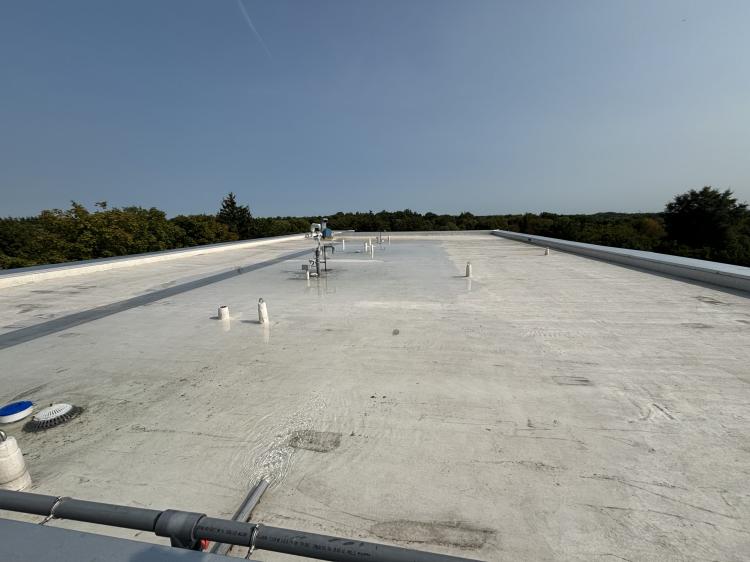Over the last few months, Mississauga has experienced two major weather events, where flooding caused damage to both public and private property. As climate change continues to evolve and more extreme weather patterns occur, cities like Mississauga are looking at innovative and adaptive drainage solutions, like blue roofs, to help with these challenges. Flooding can cause costly damage to homes, businesses and infrastructure. It can also disrupt essential services and utilities like transit and electricity. Ongoing flooding can also cause erosion, harm local ecosystems and cause debris and pollutants to contaminate our drinking water source - Lake Ontario.

Blue roofs have proven reliable in helping to reduce the risk of flood damage. They are also a cost-effective solution to mitigate some of the impacts of climate change on stormwater infrastructure, promote environmental sustainability and offset water and cooling expenses in buildings with these systems.
What is a blue roof?
Conventional roofs are sloped to shed water and use gravity to pull water downwards and off the roof through roof leaders. A blue roof is designed to capture and detain rainwater. During heavy rainfall, blue roofs can hold rainwater back, reducing and controlling the release of that water into city stormwater pipes to reduce flood-risk.
Why harvest rainwater?
Mississauga is facing increasing rainfall and more intense and frequent storm events which can cause flooding. Blue roofs offer several urban stormwater management benefits to individual properties and the wider community. Some of the stored rainwater evaporates (cooling the building), while a portion of the water can be diverted and treated for desired uses inside the building. Some may also be used for irrigation on the property.
Diverting water from the blue roof to the property landscaping allows water to soak into the soil which helps to slow the release of water into the city's stormwater system. Harvesting rainwater can also help to save the owner money on their water bill.
Greater adoption of rainwater harvesting solutions like blue roofs on suitable buildings can help alleviate pressure on the city's stormwater system, help to safeguard water quality and natural habitats, protect infrastructure and reduce flood-risk in the community.
Early success with Canada's first-ever smart blue roof
This year, through a funding partnership with Credit Valley Conservation (CVC), Mississauga became the first city in Canada to participate in the implementation of a CSA-compliant 'smart' blue roof. This innovative system is located at CVC's administration building (1255 Old Derry Rd., Mississauga, ON) and is designed to control and store up to 60,000 litres of rainwater.
According to the CVC, a 'smart' blue roof is an adaptive stormwater management technology that uses programmable logic control technology and an extensive sensor network to determine how captured rainwater is best used. The technology can decide, based on pre-determined limits, to hold the water until it evaporates, providing cooling benefits to the building, or to drain the rainwater into a harvesting tank where it can be treated and reused for non-potable purposes. It also may determine to release some of the water slowly back into the city's stormwater system during dry-weather conditions.
During floods, the smart blue roof can detain significant quantities of roof runoff that might otherwise contribute to downstream flooding or the surcharging of storm sewers. If the storage capacity of the roof is exceeded, then water is safely discharged through one of two overflow routes. The storage capacity of the roof was determined with a structural load assessment.
With its early success, the project won a 2025 Clean50 Top Project Award, showing its potential to inspire similar initiatives across Peel Region and Canada, as many municipalities are facing increased rainfall due to climate change. In its first operating season, CVC has pulled together some preliminary findings, which include:
- Successful capture and retention of rainwater from all storm events that occurred from May through to October 2024, including the July and August storms.
- A water balance from August 18 to September 6, 2024, indicates that 51 per cent of captured water was evaporated which helped to cool the building.
- 42 per cent of captured rainwater was harvested, treated and used for toilet flushing and just seven per cent was released into the municipal system during dry weather following a storm.
- A 75 per cent reduction in purchased potable water used for toilet flushing at CVC's administrative office.
This smart blue roof initiative serves as a 'living lab' and a template for future projects of this kind that fully support Mississauga's goals to encourage sustainable development in response to climate change and stormwater mitigation efforts.
The City of Mississauga's Green Development Standard (GDS) promotes environmentally friendly development of this nature through the Site Plan process. The city continues to explore low-impact development options and approaches as the city continues to drive sustainable development.
How blue roofs differ from 'green' roofs?
Green roofs offer additional benefits like air purification and habitat creation including for native pollinators, whereas blue roofs prioritize rainwater management. Green roofs are also covered with a waterproof membrane and add a thin layer of soil covered by low-maintenance plants, grasses, or other vegetation. The plants, soil and water provide insulation, permit limited evaporation that helps to cool the building and help to absorb carbon emissions.

How do 'smart' blue roofs work?
Blue roofs detain or hold back a designed maximum quantity of rainwater on the roof instead of letting it rush immediately through roof drains and underground connections to the municipal storm drains. Sensors, controls and other hardware monitor and manage water levels and detect leaks, allowing control valves in the roof leader pipes to open and close to facilitate drainage and storage. Alarms also enable staff response if needed. These controls also manage the flow of water from the roof to an existing rainwater harvesting tank for indoor and outdoor non-potable use or to the municipal stormwater system.
Data from Mississauga's 13 rainfall monitoring stations within Peel's collaborative network and its connection to the Region of Peel weather monitoring system are used to help to adjust to predicted rainfall. Water can be drained from the roof to make room for incoming stormwater when heavy rain is predicted. CVC's blue roof was able to control this summer's heavy rain and absorbed or evaporated all the water that fell on the roof storage area.
Commercial property blue roof installation
Blue roofs may support business sustainability objectives, help to reduce water costs or building cooling requirements. Installing a blue roof typically starts with a feasibility study to assess whether a building can support the system's load and what the rainwater can be used for. The study will help evaluate existing structures and outline design options. Once the design is approved, the installation, testing and ongoing maintenance can proceed.
Building a blue roof involves the installation of a special roof membrane and barrier wall to create the pre-determined rainwater storage area. Special valves within the building's roof drains control water flow and the depth of water on the roof. Small openings in the roof edge, called scuppers, serve as overflow routes, and allow water to drain to ensure the maximum capacity is never exceeded.
If rainwater will be harvested, a storage tank must be installed inside the building based on the anticipated storage requirements. For use of rainwater as a non-potable source of water for toilets, a suitable water treatment system must also be included. For use as a potable water source, suitable for consumption or for handwashing etc., a more complex water treatment system is required.
The future of blue roofs in Mississauga
Mississauga is proud to be the first city in Canada to embrace a CSA-compliant smart blue roof system. Credit Valley Conservation's success with their smart blue roof, constructed with support from the City of Mississauga, demonstrates how both organizations are committed to collaboration and to finding innovative solutions for increasing climate challenges.
As weather patterns continue to change, wide-spread community adoption of technology like blue roofs can help to mitigate the impacts of heavy rainfall and storms. Learn more about CVC's and the City of Mississauga's smart blue roof project.



















